University Financial Accounting: Liquidation of Companies Report
VerifiedAdded on 2021/06/14
|11
|2872
|91
Report
AI Summary
This report provides an in-depth analysis of the liquidation of three companies: ABC Learning, HIH Insurance, and One Tel. It examines the events leading to their financial distress and eventual collapse, focusing on the role of debt accumulation, unethical practices, and governance failures. The report details how ABC Learning's rapid expansion, fueled by excessive debt, led to its downfall, while also highlighting the manipulation of financial reports by its CEO. The analysis further explores the ethical and governance issues within HIH Insurance, including aggressive expansion, risky insurance premiums, and market manipulation. Finally, the report investigates One Tel's failure, attributing it to unethical measures, poor financial reporting, and the impact of liabilities. The report concludes by summarizing the critical role liabilities played in the liquidation of all three companies.
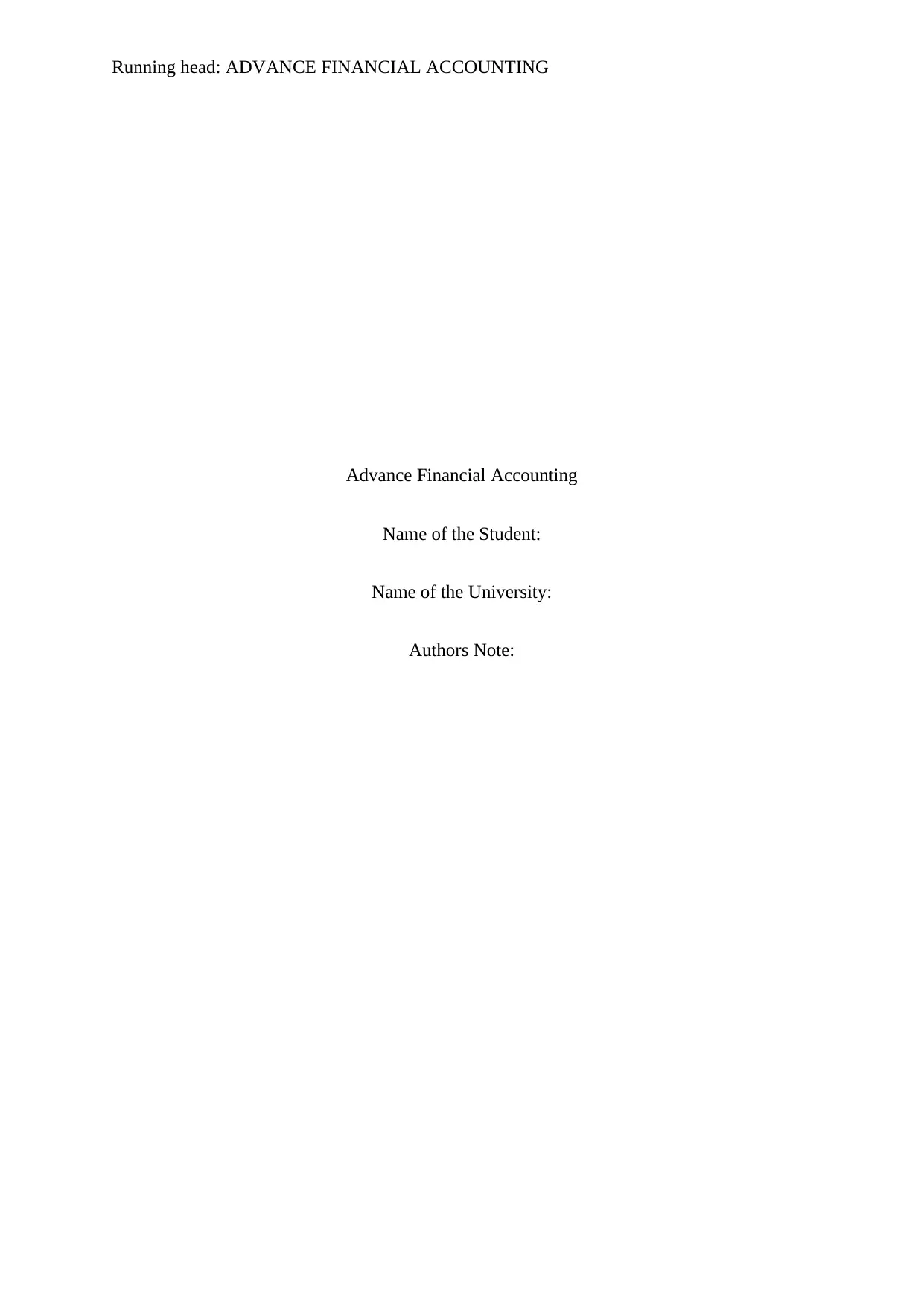
Running head: ADVANCE FINANCIAL ACCOUNTING
Advance Financial Accounting
Name of the Student:
Name of the University:
Authors Note:
Advance Financial Accounting
Name of the Student:
Name of the University:
Authors Note:
Paraphrase This Document
Need a fresh take? Get an instant paraphrase of this document with our AI Paraphraser
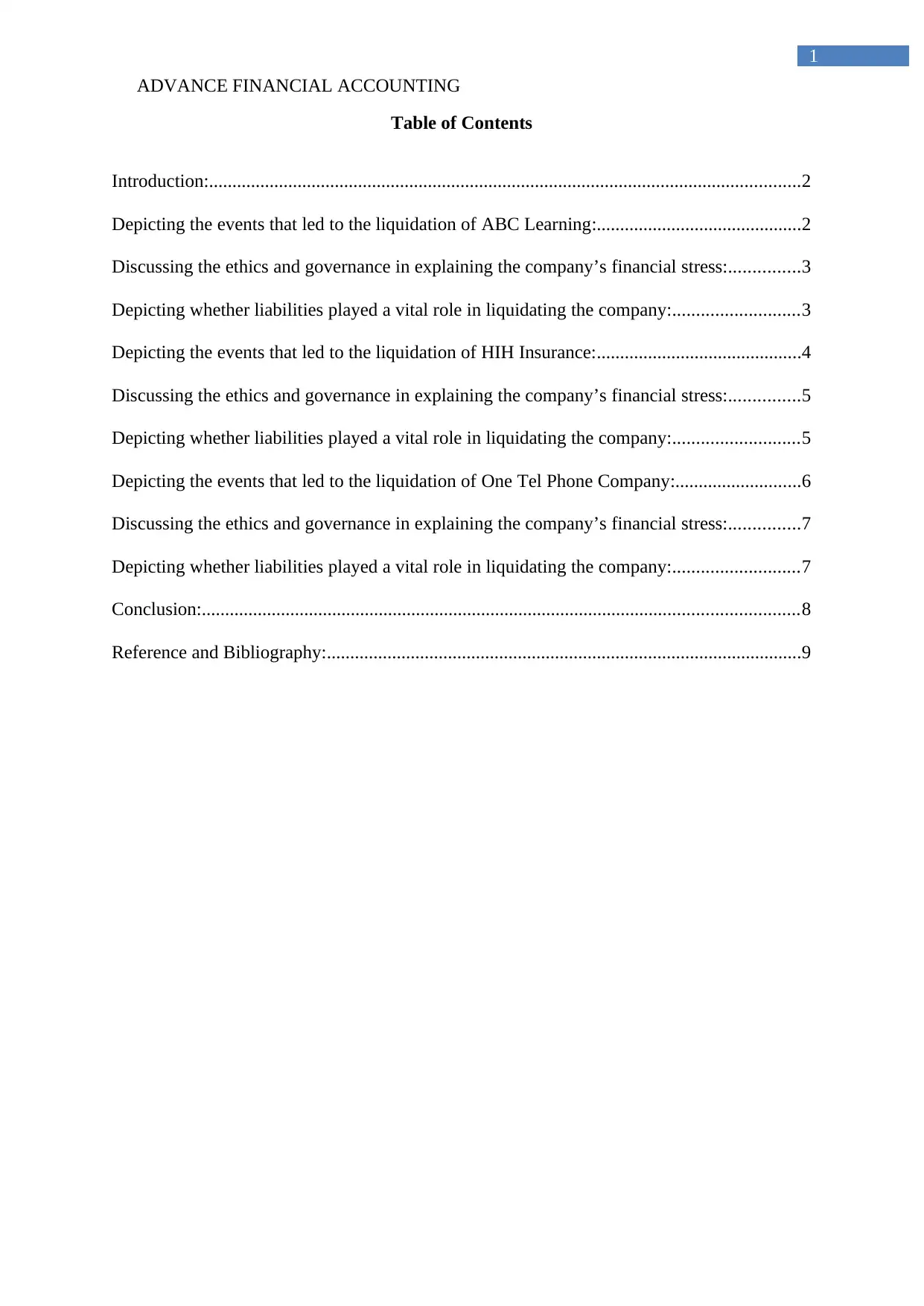
ADVANCE FINANCIAL ACCOUNTING
1
Table of Contents
Introduction:...............................................................................................................................2
Depicting the events that led to the liquidation of ABC Learning:............................................2
Discussing the ethics and governance in explaining the company’s financial stress:...............3
Depicting whether liabilities played a vital role in liquidating the company:...........................3
Depicting the events that led to the liquidation of HIH Insurance:............................................4
Discussing the ethics and governance in explaining the company’s financial stress:...............5
Depicting whether liabilities played a vital role in liquidating the company:...........................5
Depicting the events that led to the liquidation of One Tel Phone Company:...........................6
Discussing the ethics and governance in explaining the company’s financial stress:...............7
Depicting whether liabilities played a vital role in liquidating the company:...........................7
Conclusion:................................................................................................................................8
Reference and Bibliography:......................................................................................................9
1
Table of Contents
Introduction:...............................................................................................................................2
Depicting the events that led to the liquidation of ABC Learning:............................................2
Discussing the ethics and governance in explaining the company’s financial stress:...............3
Depicting whether liabilities played a vital role in liquidating the company:...........................3
Depicting the events that led to the liquidation of HIH Insurance:............................................4
Discussing the ethics and governance in explaining the company’s financial stress:...............5
Depicting whether liabilities played a vital role in liquidating the company:...........................5
Depicting the events that led to the liquidation of One Tel Phone Company:...........................6
Discussing the ethics and governance in explaining the company’s financial stress:...............7
Depicting whether liabilities played a vital role in liquidating the company:...........................7
Conclusion:................................................................................................................................8
Reference and Bibliography:......................................................................................................9
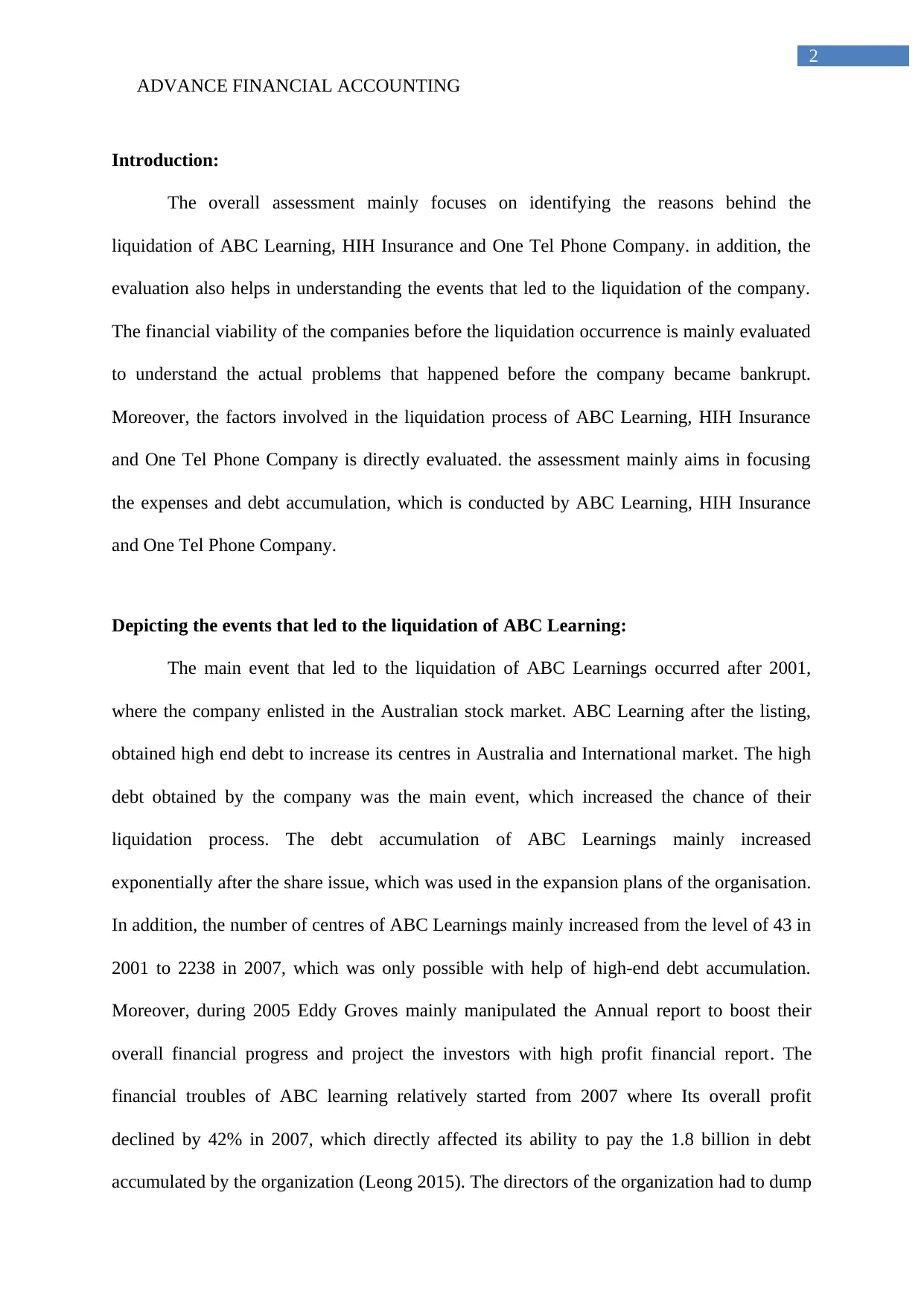
ADVANCE FINANCIAL ACCOUNTING
2
Introduction:
The overall assessment mainly focuses on identifying the reasons behind the
liquidation of ABC Learning, HIH Insurance and One Tel Phone Company. in addition, the
evaluation also helps in understanding the events that led to the liquidation of the company.
The financial viability of the companies before the liquidation occurrence is mainly evaluated
to understand the actual problems that happened before the company became bankrupt.
Moreover, the factors involved in the liquidation process of ABC Learning, HIH Insurance
and One Tel Phone Company is directly evaluated. the assessment mainly aims in focusing
the expenses and debt accumulation, which is conducted by ABC Learning, HIH Insurance
and One Tel Phone Company.
Depicting the events that led to the liquidation of ABC Learning:
The main event that led to the liquidation of ABC Learnings occurred after 2001,
where the company enlisted in the Australian stock market. ABC Learning after the listing,
obtained high end debt to increase its centres in Australia and International market. The high
debt obtained by the company was the main event, which increased the chance of their
liquidation process. The debt accumulation of ABC Learnings mainly increased
exponentially after the share issue, which was used in the expansion plans of the organisation.
In addition, the number of centres of ABC Learnings mainly increased from the level of 43 in
2001 to 2238 in 2007, which was only possible with help of high-end debt accumulation.
Moreover, during 2005 Eddy Groves mainly manipulated the Annual report to boost their
overall financial progress and project the investors with high profit financial report. The
financial troubles of ABC learning relatively started from 2007 where Its overall profit
declined by 42% in 2007, which directly affected its ability to pay the 1.8 billion in debt
accumulated by the organization (Leong 2015). The directors of the organization had to dump
2
Introduction:
The overall assessment mainly focuses on identifying the reasons behind the
liquidation of ABC Learning, HIH Insurance and One Tel Phone Company. in addition, the
evaluation also helps in understanding the events that led to the liquidation of the company.
The financial viability of the companies before the liquidation occurrence is mainly evaluated
to understand the actual problems that happened before the company became bankrupt.
Moreover, the factors involved in the liquidation process of ABC Learning, HIH Insurance
and One Tel Phone Company is directly evaluated. the assessment mainly aims in focusing
the expenses and debt accumulation, which is conducted by ABC Learning, HIH Insurance
and One Tel Phone Company.
Depicting the events that led to the liquidation of ABC Learning:
The main event that led to the liquidation of ABC Learnings occurred after 2001,
where the company enlisted in the Australian stock market. ABC Learning after the listing,
obtained high end debt to increase its centres in Australia and International market. The high
debt obtained by the company was the main event, which increased the chance of their
liquidation process. The debt accumulation of ABC Learnings mainly increased
exponentially after the share issue, which was used in the expansion plans of the organisation.
In addition, the number of centres of ABC Learnings mainly increased from the level of 43 in
2001 to 2238 in 2007, which was only possible with help of high-end debt accumulation.
Moreover, during 2005 Eddy Groves mainly manipulated the Annual report to boost their
overall financial progress and project the investors with high profit financial report. The
financial troubles of ABC learning relatively started from 2007 where Its overall profit
declined by 42% in 2007, which directly affected its ability to pay the 1.8 billion in debt
accumulated by the organization (Leong 2015). The directors of the organization had to dump
⊘ This is a preview!⊘
Do you want full access?
Subscribe today to unlock all pages.

Trusted by 1+ million students worldwide
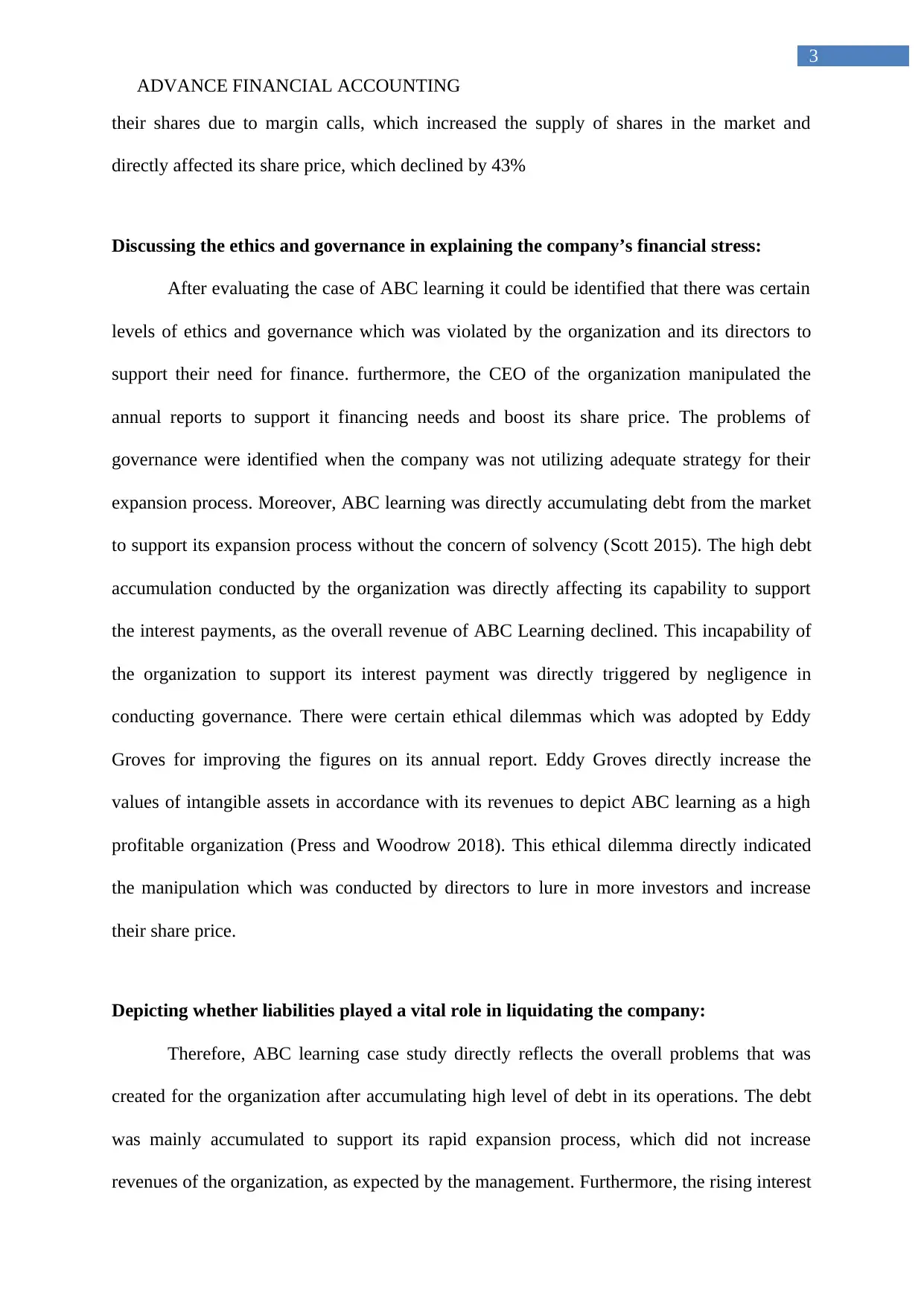
ADVANCE FINANCIAL ACCOUNTING
3
their shares due to margin calls, which increased the supply of shares in the market and
directly affected its share price, which declined by 43%
Discussing the ethics and governance in explaining the company’s financial stress:
After evaluating the case of ABC learning it could be identified that there was certain
levels of ethics and governance which was violated by the organization and its directors to
support their need for finance. furthermore, the CEO of the organization manipulated the
annual reports to support it financing needs and boost its share price. The problems of
governance were identified when the company was not utilizing adequate strategy for their
expansion process. Moreover, ABC learning was directly accumulating debt from the market
to support its expansion process without the concern of solvency (Scott 2015). The high debt
accumulation conducted by the organization was directly affecting its capability to support
the interest payments, as the overall revenue of ABC Learning declined. This incapability of
the organization to support its interest payment was directly triggered by negligence in
conducting governance. There were certain ethical dilemmas which was adopted by Eddy
Groves for improving the figures on its annual report. Eddy Groves directly increase the
values of intangible assets in accordance with its revenues to depict ABC learning as a high
profitable organization (Press and Woodrow 2018). This ethical dilemma directly indicated
the manipulation which was conducted by directors to lure in more investors and increase
their share price.
Depicting whether liabilities played a vital role in liquidating the company:
Therefore, ABC learning case study directly reflects the overall problems that was
created for the organization after accumulating high level of debt in its operations. The debt
was mainly accumulated to support its rapid expansion process, which did not increase
revenues of the organization, as expected by the management. Furthermore, the rising interest
3
their shares due to margin calls, which increased the supply of shares in the market and
directly affected its share price, which declined by 43%
Discussing the ethics and governance in explaining the company’s financial stress:
After evaluating the case of ABC learning it could be identified that there was certain
levels of ethics and governance which was violated by the organization and its directors to
support their need for finance. furthermore, the CEO of the organization manipulated the
annual reports to support it financing needs and boost its share price. The problems of
governance were identified when the company was not utilizing adequate strategy for their
expansion process. Moreover, ABC learning was directly accumulating debt from the market
to support its expansion process without the concern of solvency (Scott 2015). The high debt
accumulation conducted by the organization was directly affecting its capability to support
the interest payments, as the overall revenue of ABC Learning declined. This incapability of
the organization to support its interest payment was directly triggered by negligence in
conducting governance. There were certain ethical dilemmas which was adopted by Eddy
Groves for improving the figures on its annual report. Eddy Groves directly increase the
values of intangible assets in accordance with its revenues to depict ABC learning as a high
profitable organization (Press and Woodrow 2018). This ethical dilemma directly indicated
the manipulation which was conducted by directors to lure in more investors and increase
their share price.
Depicting whether liabilities played a vital role in liquidating the company:
Therefore, ABC learning case study directly reflects the overall problems that was
created for the organization after accumulating high level of debt in its operations. The debt
was mainly accumulated to support its rapid expansion process, which did not increase
revenues of the organization, as expected by the management. Furthermore, the rising interest
Paraphrase This Document
Need a fresh take? Get an instant paraphrase of this document with our AI Paraphraser
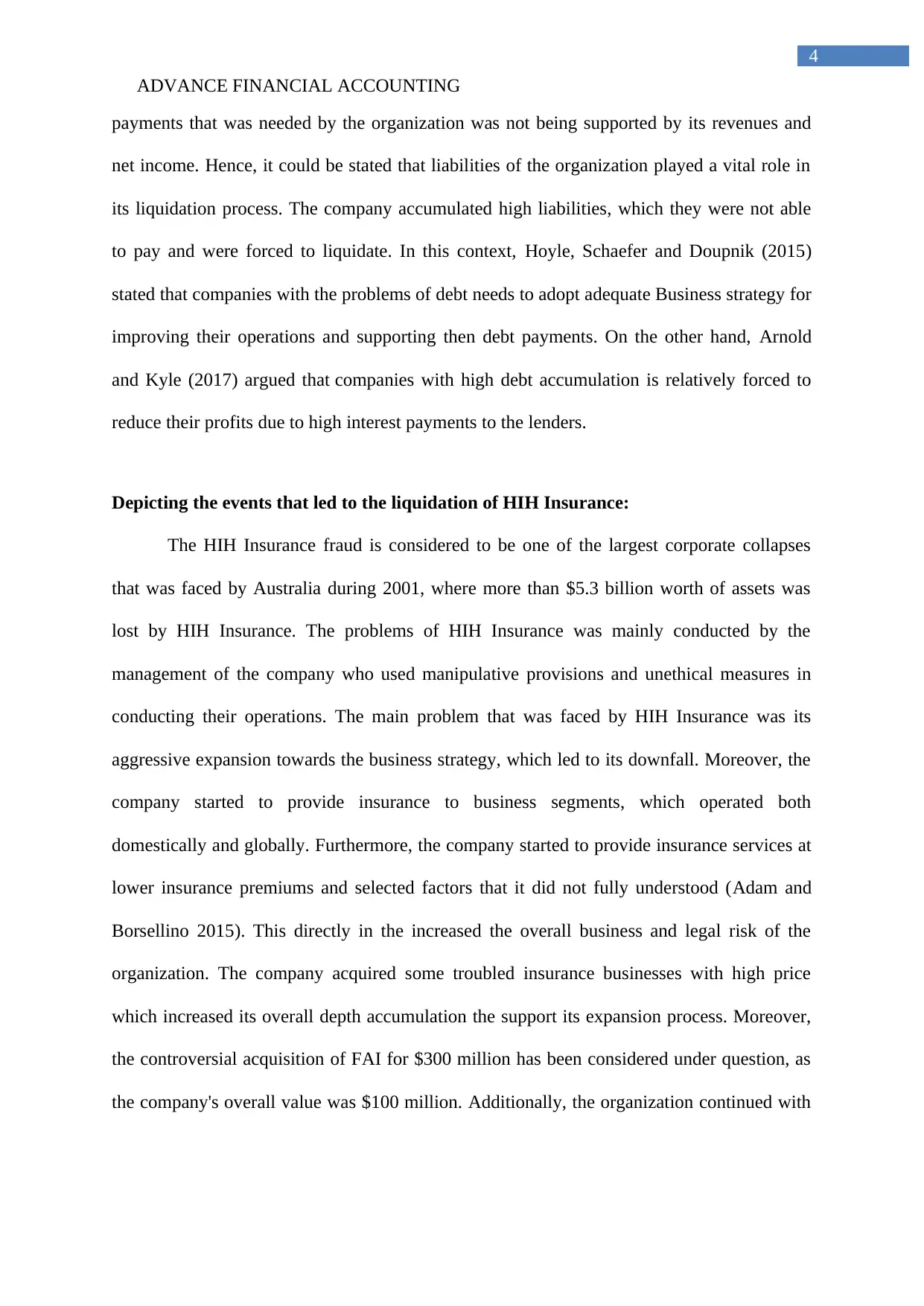
ADVANCE FINANCIAL ACCOUNTING
4
payments that was needed by the organization was not being supported by its revenues and
net income. Hence, it could be stated that liabilities of the organization played a vital role in
its liquidation process. The company accumulated high liabilities, which they were not able
to pay and were forced to liquidate. In this context, Hoyle, Schaefer and Doupnik (2015)
stated that companies with the problems of debt needs to adopt adequate Business strategy for
improving their operations and supporting then debt payments. On the other hand, Arnold
and Kyle (2017) argued that companies with high debt accumulation is relatively forced to
reduce their profits due to high interest payments to the lenders.
Depicting the events that led to the liquidation of HIH Insurance:
The HIH Insurance fraud is considered to be one of the largest corporate collapses
that was faced by Australia during 2001, where more than $5.3 billion worth of assets was
lost by HIH Insurance. The problems of HIH Insurance was mainly conducted by the
management of the company who used manipulative provisions and unethical measures in
conducting their operations. The main problem that was faced by HIH Insurance was its
aggressive expansion towards the business strategy, which led to its downfall. Moreover, the
company started to provide insurance to business segments, which operated both
domestically and globally. Furthermore, the company started to provide insurance services at
lower insurance premiums and selected factors that it did not fully understood (Adam and
Borsellino 2015). This directly in the increased the overall business and legal risk of the
organization. The company acquired some troubled insurance businesses with high price
which increased its overall depth accumulation the support its expansion process. Moreover,
the controversial acquisition of FAI for $300 million has been considered under question, as
the company's overall value was $100 million. Additionally, the organization continued with
4
payments that was needed by the organization was not being supported by its revenues and
net income. Hence, it could be stated that liabilities of the organization played a vital role in
its liquidation process. The company accumulated high liabilities, which they were not able
to pay and were forced to liquidate. In this context, Hoyle, Schaefer and Doupnik (2015)
stated that companies with the problems of debt needs to adopt adequate Business strategy for
improving their operations and supporting then debt payments. On the other hand, Arnold
and Kyle (2017) argued that companies with high debt accumulation is relatively forced to
reduce their profits due to high interest payments to the lenders.
Depicting the events that led to the liquidation of HIH Insurance:
The HIH Insurance fraud is considered to be one of the largest corporate collapses
that was faced by Australia during 2001, where more than $5.3 billion worth of assets was
lost by HIH Insurance. The problems of HIH Insurance was mainly conducted by the
management of the company who used manipulative provisions and unethical measures in
conducting their operations. The main problem that was faced by HIH Insurance was its
aggressive expansion towards the business strategy, which led to its downfall. Moreover, the
company started to provide insurance to business segments, which operated both
domestically and globally. Furthermore, the company started to provide insurance services at
lower insurance premiums and selected factors that it did not fully understood (Adam and
Borsellino 2015). This directly in the increased the overall business and legal risk of the
organization. The company acquired some troubled insurance businesses with high price
which increased its overall depth accumulation the support its expansion process. Moreover,
the controversial acquisition of FAI for $300 million has been considered under question, as
the company's overall value was $100 million. Additionally, the organization continued with
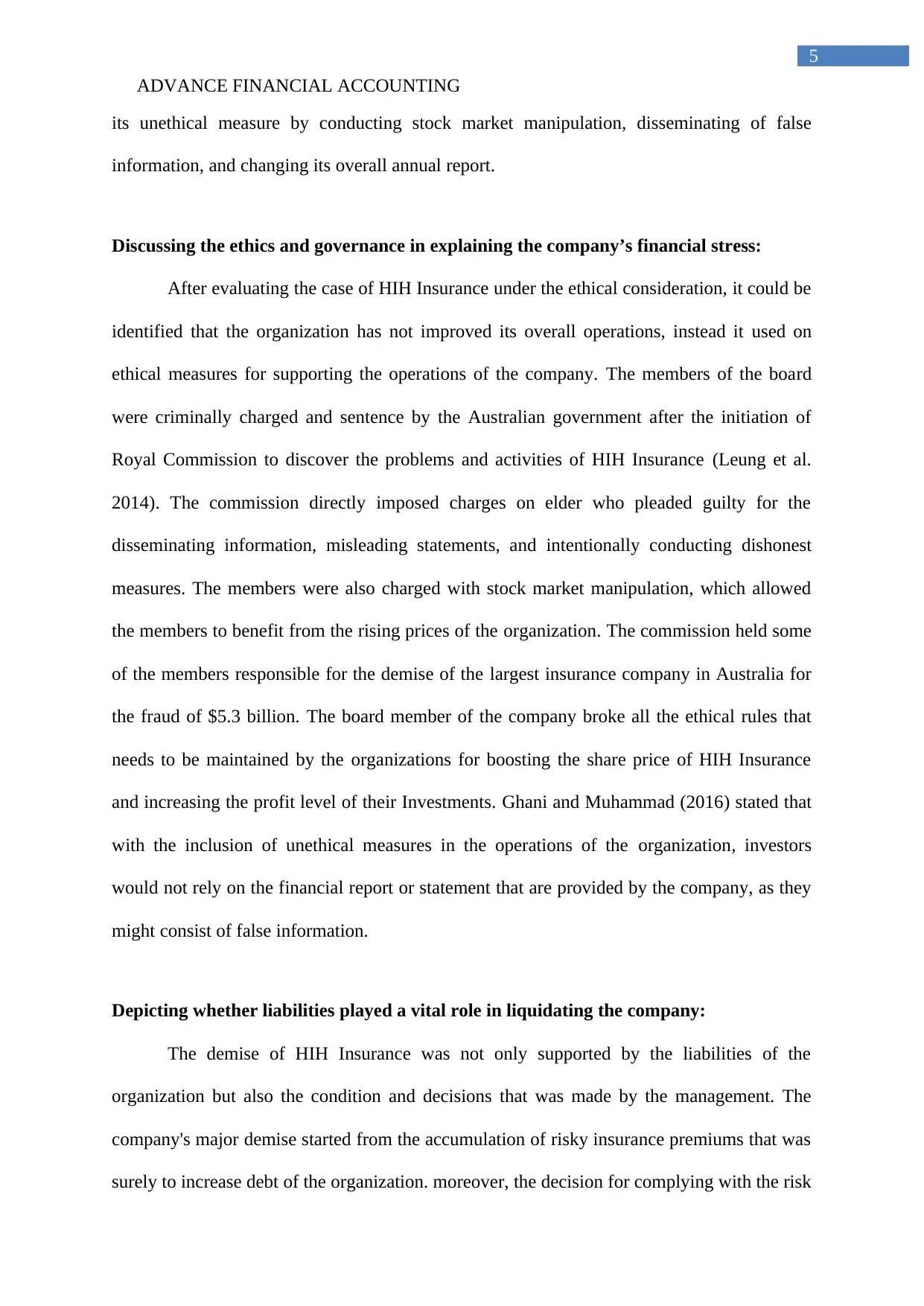
ADVANCE FINANCIAL ACCOUNTING
5
its unethical measure by conducting stock market manipulation, disseminating of false
information, and changing its overall annual report.
Discussing the ethics and governance in explaining the company’s financial stress:
After evaluating the case of HIH Insurance under the ethical consideration, it could be
identified that the organization has not improved its overall operations, instead it used on
ethical measures for supporting the operations of the company. The members of the board
were criminally charged and sentence by the Australian government after the initiation of
Royal Commission to discover the problems and activities of HIH Insurance (Leung et al.
2014). The commission directly imposed charges on elder who pleaded guilty for the
disseminating information, misleading statements, and intentionally conducting dishonest
measures. The members were also charged with stock market manipulation, which allowed
the members to benefit from the rising prices of the organization. The commission held some
of the members responsible for the demise of the largest insurance company in Australia for
the fraud of $5.3 billion. The board member of the company broke all the ethical rules that
needs to be maintained by the organizations for boosting the share price of HIH Insurance
and increasing the profit level of their Investments. Ghani and Muhammad (2016) stated that
with the inclusion of unethical measures in the operations of the organization, investors
would not rely on the financial report or statement that are provided by the company, as they
might consist of false information.
Depicting whether liabilities played a vital role in liquidating the company:
The demise of HIH Insurance was not only supported by the liabilities of the
organization but also the condition and decisions that was made by the management. The
company's major demise started from the accumulation of risky insurance premiums that was
surely to increase debt of the organization. moreover, the decision for complying with the risk
5
its unethical measure by conducting stock market manipulation, disseminating of false
information, and changing its overall annual report.
Discussing the ethics and governance in explaining the company’s financial stress:
After evaluating the case of HIH Insurance under the ethical consideration, it could be
identified that the organization has not improved its overall operations, instead it used on
ethical measures for supporting the operations of the company. The members of the board
were criminally charged and sentence by the Australian government after the initiation of
Royal Commission to discover the problems and activities of HIH Insurance (Leung et al.
2014). The commission directly imposed charges on elder who pleaded guilty for the
disseminating information, misleading statements, and intentionally conducting dishonest
measures. The members were also charged with stock market manipulation, which allowed
the members to benefit from the rising prices of the organization. The commission held some
of the members responsible for the demise of the largest insurance company in Australia for
the fraud of $5.3 billion. The board member of the company broke all the ethical rules that
needs to be maintained by the organizations for boosting the share price of HIH Insurance
and increasing the profit level of their Investments. Ghani and Muhammad (2016) stated that
with the inclusion of unethical measures in the operations of the organization, investors
would not rely on the financial report or statement that are provided by the company, as they
might consist of false information.
Depicting whether liabilities played a vital role in liquidating the company:
The demise of HIH Insurance was not only supported by the liabilities of the
organization but also the condition and decisions that was made by the management. The
company's major demise started from the accumulation of risky insurance premiums that was
surely to increase debt of the organization. moreover, the decision for complying with the risk
⊘ This is a preview!⊘
Do you want full access?
Subscribe today to unlock all pages.

Trusted by 1+ million students worldwide
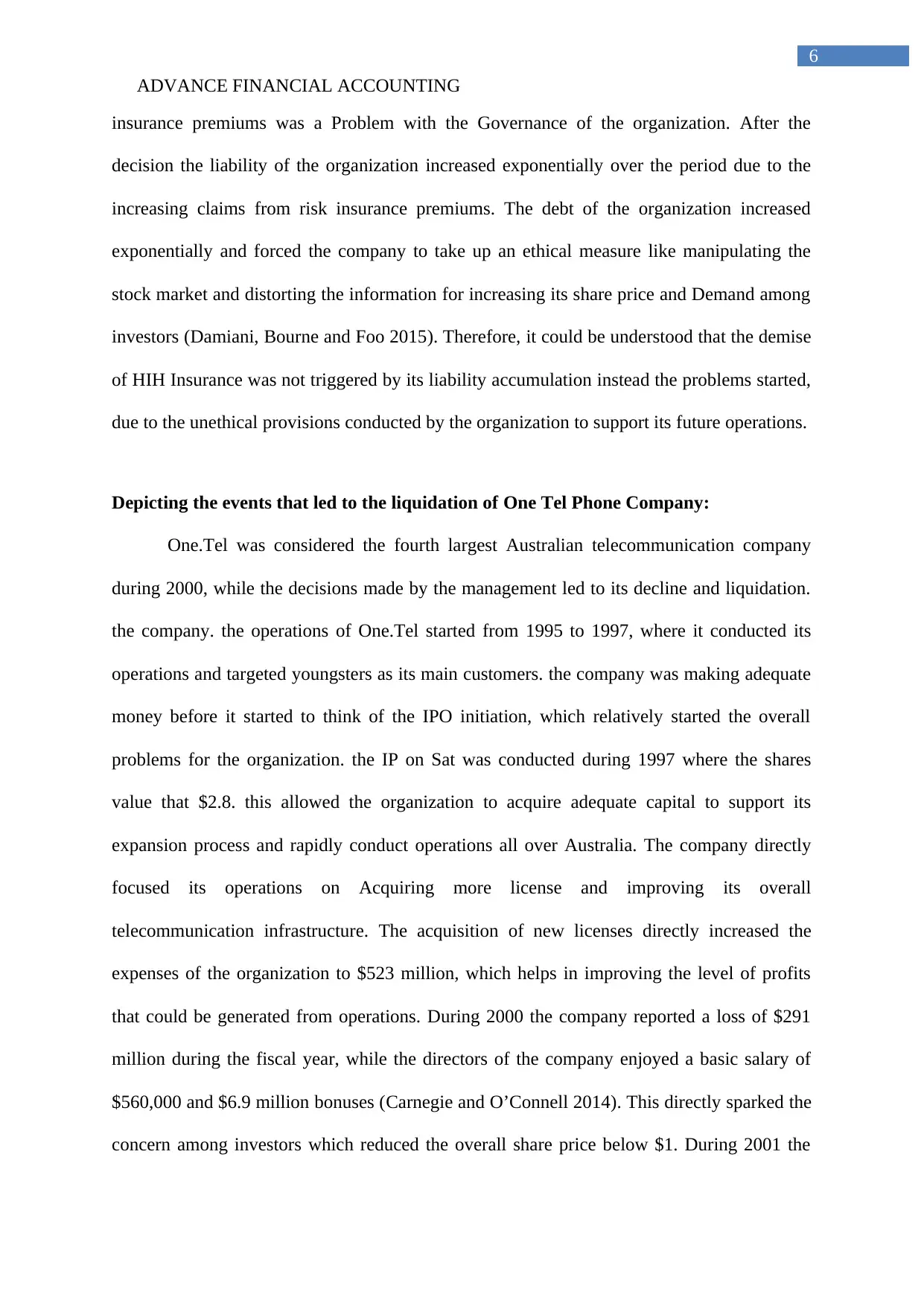
ADVANCE FINANCIAL ACCOUNTING
6
insurance premiums was a Problem with the Governance of the organization. After the
decision the liability of the organization increased exponentially over the period due to the
increasing claims from risk insurance premiums. The debt of the organization increased
exponentially and forced the company to take up an ethical measure like manipulating the
stock market and distorting the information for increasing its share price and Demand among
investors (Damiani, Bourne and Foo 2015). Therefore, it could be understood that the demise
of HIH Insurance was not triggered by its liability accumulation instead the problems started,
due to the unethical provisions conducted by the organization to support its future operations.
Depicting the events that led to the liquidation of One Tel Phone Company:
One.Tel was considered the fourth largest Australian telecommunication company
during 2000, while the decisions made by the management led to its decline and liquidation.
the company. the operations of One.Tel started from 1995 to 1997, where it conducted its
operations and targeted youngsters as its main customers. the company was making adequate
money before it started to think of the IPO initiation, which relatively started the overall
problems for the organization. the IP on Sat was conducted during 1997 where the shares
value that $2.8. this allowed the organization to acquire adequate capital to support its
expansion process and rapidly conduct operations all over Australia. The company directly
focused its operations on Acquiring more license and improving its overall
telecommunication infrastructure. The acquisition of new licenses directly increased the
expenses of the organization to $523 million, which helps in improving the level of profits
that could be generated from operations. During 2000 the company reported a loss of $291
million during the fiscal year, while the directors of the company enjoyed a basic salary of
$560,000 and $6.9 million bonuses (Carnegie and O’Connell 2014). This directly sparked the
concern among investors which reduced the overall share price below $1. During 2001 the
6
insurance premiums was a Problem with the Governance of the organization. After the
decision the liability of the organization increased exponentially over the period due to the
increasing claims from risk insurance premiums. The debt of the organization increased
exponentially and forced the company to take up an ethical measure like manipulating the
stock market and distorting the information for increasing its share price and Demand among
investors (Damiani, Bourne and Foo 2015). Therefore, it could be understood that the demise
of HIH Insurance was not triggered by its liability accumulation instead the problems started,
due to the unethical provisions conducted by the organization to support its future operations.
Depicting the events that led to the liquidation of One Tel Phone Company:
One.Tel was considered the fourth largest Australian telecommunication company
during 2000, while the decisions made by the management led to its decline and liquidation.
the company. the operations of One.Tel started from 1995 to 1997, where it conducted its
operations and targeted youngsters as its main customers. the company was making adequate
money before it started to think of the IPO initiation, which relatively started the overall
problems for the organization. the IP on Sat was conducted during 1997 where the shares
value that $2.8. this allowed the organization to acquire adequate capital to support its
expansion process and rapidly conduct operations all over Australia. The company directly
focused its operations on Acquiring more license and improving its overall
telecommunication infrastructure. The acquisition of new licenses directly increased the
expenses of the organization to $523 million, which helps in improving the level of profits
that could be generated from operations. During 2000 the company reported a loss of $291
million during the fiscal year, while the directors of the company enjoyed a basic salary of
$560,000 and $6.9 million bonuses (Carnegie and O’Connell 2014). This directly sparked the
concern among investors which reduced the overall share price below $1. During 2001 the
Paraphrase This Document
Need a fresh take? Get an instant paraphrase of this document with our AI Paraphraser
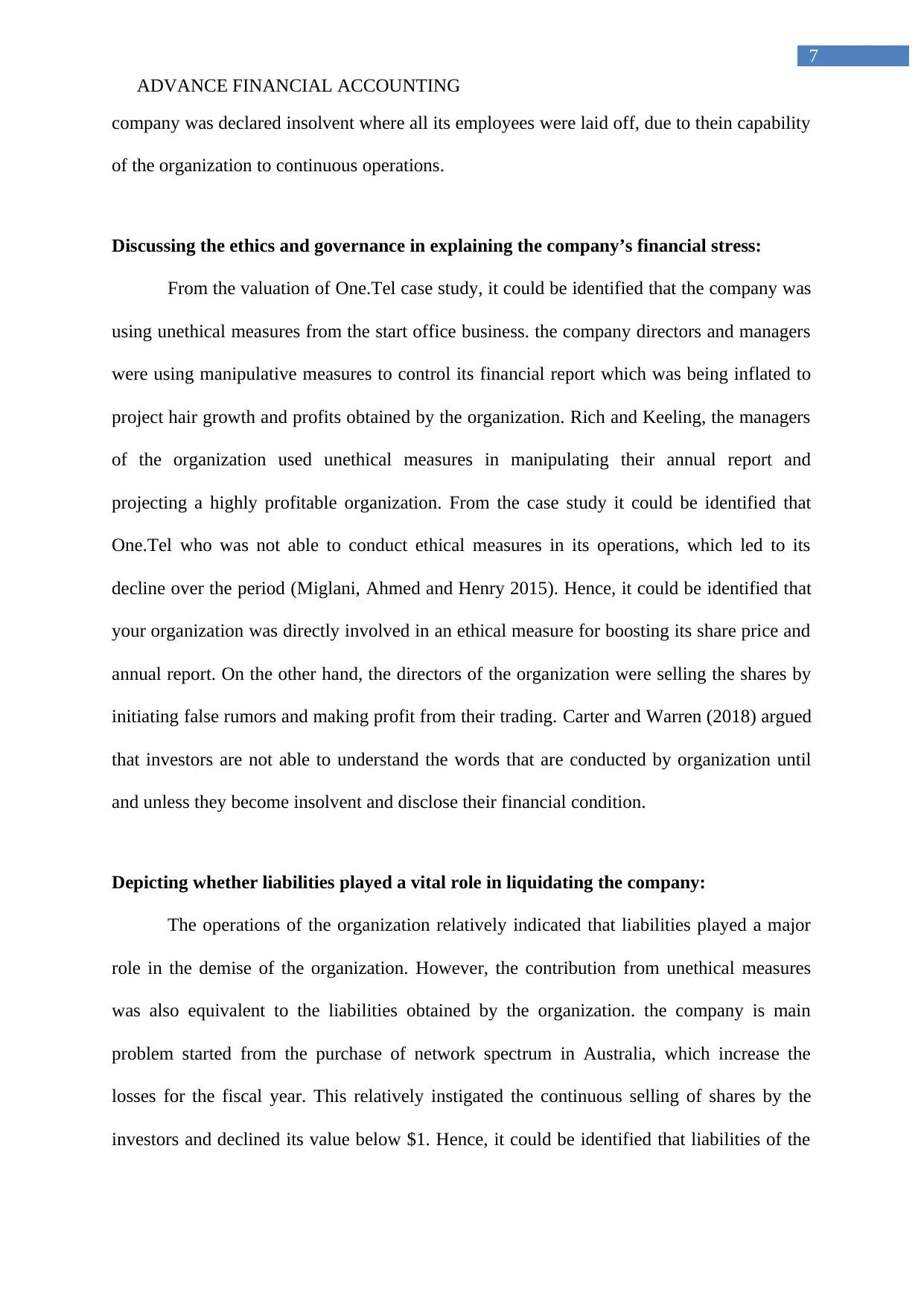
ADVANCE FINANCIAL ACCOUNTING
7
company was declared insolvent where all its employees were laid off, due to thein capability
of the organization to continuous operations.
Discussing the ethics and governance in explaining the company’s financial stress:
From the valuation of One.Tel case study, it could be identified that the company was
using unethical measures from the start office business. the company directors and managers
were using manipulative measures to control its financial report which was being inflated to
project hair growth and profits obtained by the organization. Rich and Keeling, the managers
of the organization used unethical measures in manipulating their annual report and
projecting a highly profitable organization. From the case study it could be identified that
One.Tel who was not able to conduct ethical measures in its operations, which led to its
decline over the period (Miglani, Ahmed and Henry 2015). Hence, it could be identified that
your organization was directly involved in an ethical measure for boosting its share price and
annual report. On the other hand, the directors of the organization were selling the shares by
initiating false rumors and making profit from their trading. Carter and Warren (2018) argued
that investors are not able to understand the words that are conducted by organization until
and unless they become insolvent and disclose their financial condition.
Depicting whether liabilities played a vital role in liquidating the company:
The operations of the organization relatively indicated that liabilities played a major
role in the demise of the organization. However, the contribution from unethical measures
was also equivalent to the liabilities obtained by the organization. the company is main
problem started from the purchase of network spectrum in Australia, which increase the
losses for the fiscal year. This relatively instigated the continuous selling of shares by the
investors and declined its value below $1. Hence, it could be identified that liabilities of the
7
company was declared insolvent where all its employees were laid off, due to thein capability
of the organization to continuous operations.
Discussing the ethics and governance in explaining the company’s financial stress:
From the valuation of One.Tel case study, it could be identified that the company was
using unethical measures from the start office business. the company directors and managers
were using manipulative measures to control its financial report which was being inflated to
project hair growth and profits obtained by the organization. Rich and Keeling, the managers
of the organization used unethical measures in manipulating their annual report and
projecting a highly profitable organization. From the case study it could be identified that
One.Tel who was not able to conduct ethical measures in its operations, which led to its
decline over the period (Miglani, Ahmed and Henry 2015). Hence, it could be identified that
your organization was directly involved in an ethical measure for boosting its share price and
annual report. On the other hand, the directors of the organization were selling the shares by
initiating false rumors and making profit from their trading. Carter and Warren (2018) argued
that investors are not able to understand the words that are conducted by organization until
and unless they become insolvent and disclose their financial condition.
Depicting whether liabilities played a vital role in liquidating the company:
The operations of the organization relatively indicated that liabilities played a major
role in the demise of the organization. However, the contribution from unethical measures
was also equivalent to the liabilities obtained by the organization. the company is main
problem started from the purchase of network spectrum in Australia, which increase the
losses for the fiscal year. This relatively instigated the continuous selling of shares by the
investors and declined its value below $1. Hence, it could be identified that liabilities of the
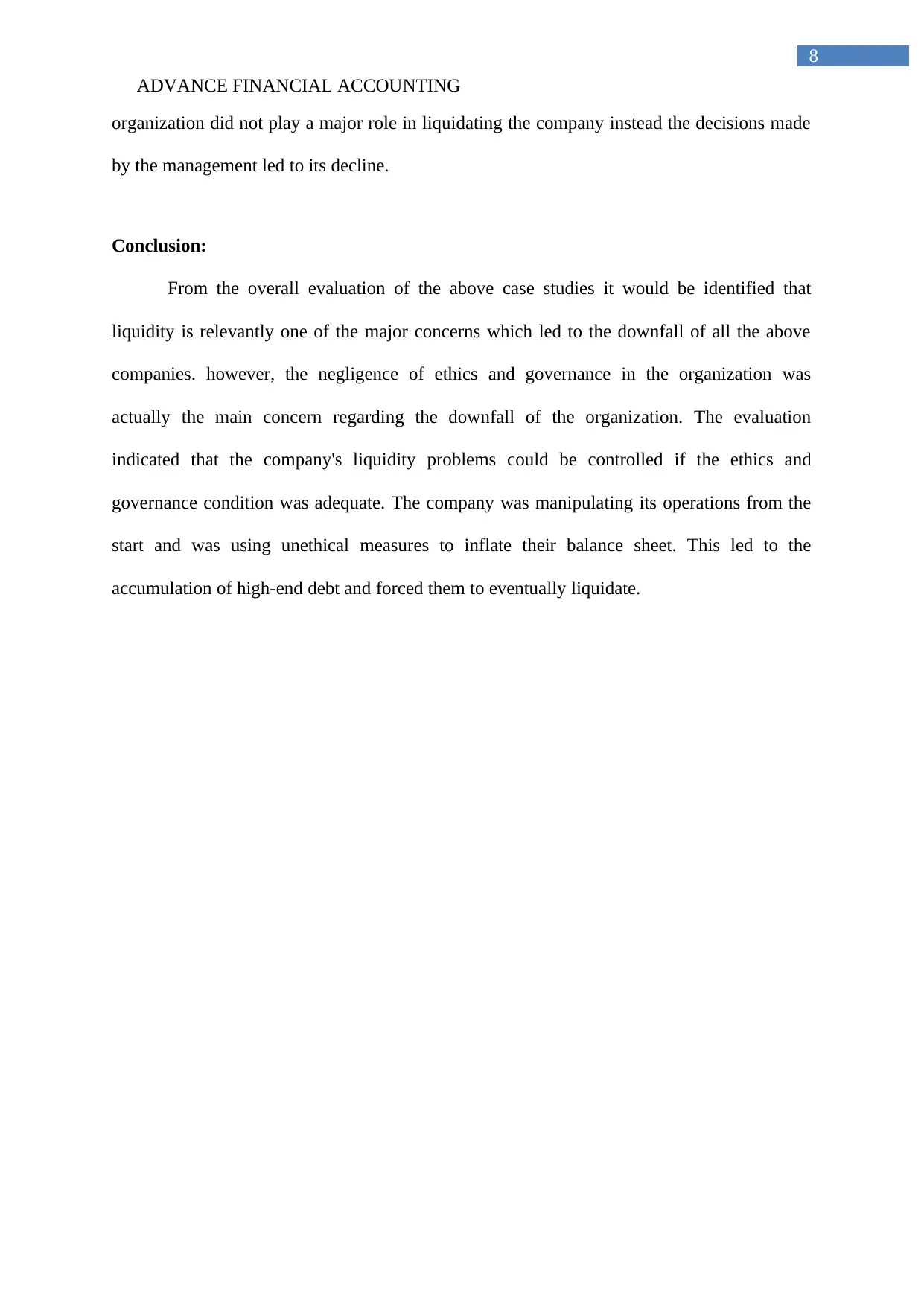
ADVANCE FINANCIAL ACCOUNTING
8
organization did not play a major role in liquidating the company instead the decisions made
by the management led to its decline.
Conclusion:
From the overall evaluation of the above case studies it would be identified that
liquidity is relevantly one of the major concerns which led to the downfall of all the above
companies. however, the negligence of ethics and governance in the organization was
actually the main concern regarding the downfall of the organization. The evaluation
indicated that the company's liquidity problems could be controlled if the ethics and
governance condition was adequate. The company was manipulating its operations from the
start and was using unethical measures to inflate their balance sheet. This led to the
accumulation of high-end debt and forced them to eventually liquidate.
8
organization did not play a major role in liquidating the company instead the decisions made
by the management led to its decline.
Conclusion:
From the overall evaluation of the above case studies it would be identified that
liquidity is relevantly one of the major concerns which led to the downfall of all the above
companies. however, the negligence of ethics and governance in the organization was
actually the main concern regarding the downfall of the organization. The evaluation
indicated that the company's liquidity problems could be controlled if the ethics and
governance condition was adequate. The company was manipulating its operations from the
start and was using unethical measures to inflate their balance sheet. This led to the
accumulation of high-end debt and forced them to eventually liquidate.
⊘ This is a preview!⊘
Do you want full access?
Subscribe today to unlock all pages.

Trusted by 1+ million students worldwide
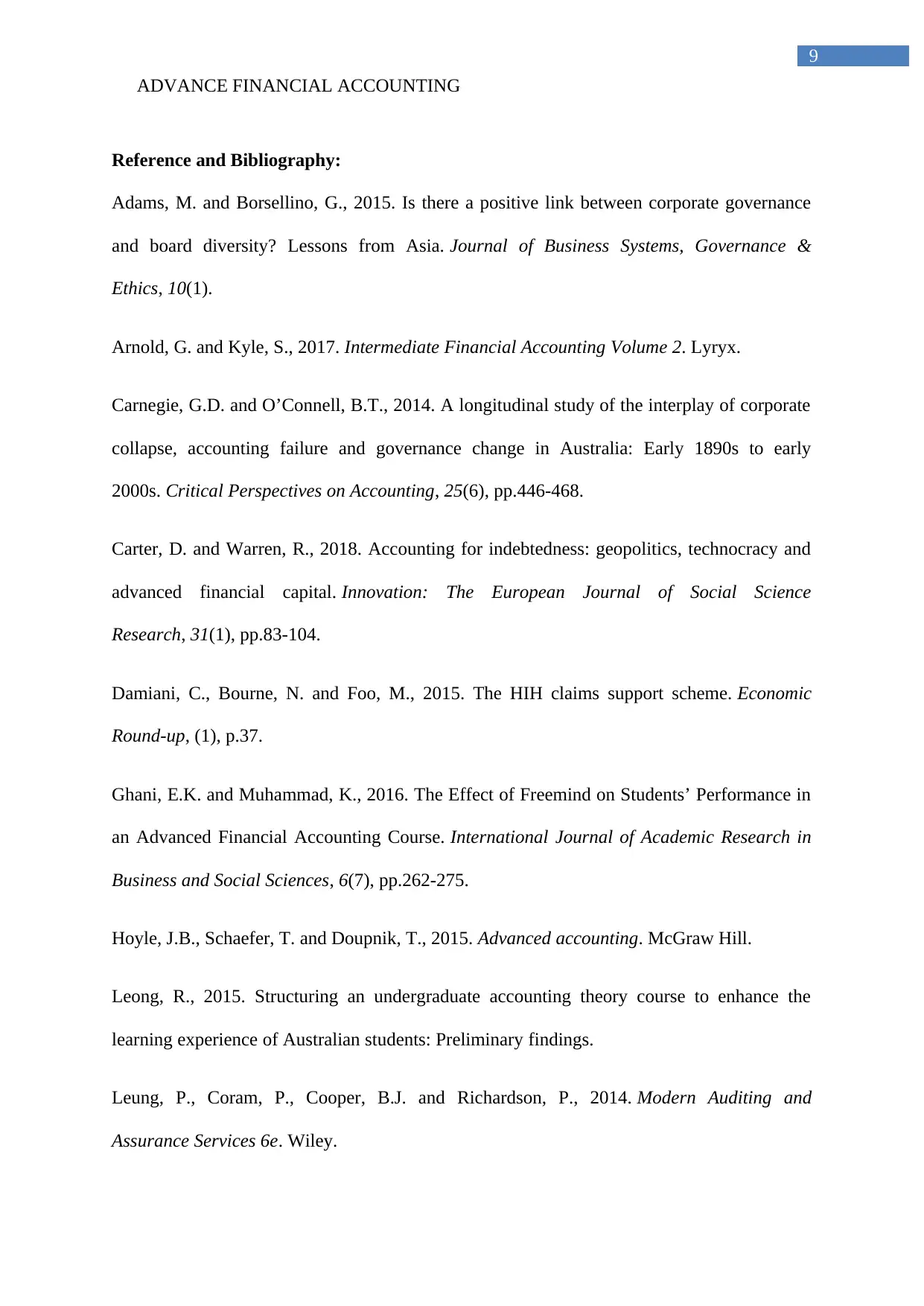
ADVANCE FINANCIAL ACCOUNTING
9
Reference and Bibliography:
Adams, M. and Borsellino, G., 2015. Is there a positive link between corporate governance
and board diversity? Lessons from Asia. Journal of Business Systems, Governance &
Ethics, 10(1).
Arnold, G. and Kyle, S., 2017. Intermediate Financial Accounting Volume 2. Lyryx.
Carnegie, G.D. and O’Connell, B.T., 2014. A longitudinal study of the interplay of corporate
collapse, accounting failure and governance change in Australia: Early 1890s to early
2000s. Critical Perspectives on Accounting, 25(6), pp.446-468.
Carter, D. and Warren, R., 2018. Accounting for indebtedness: geopolitics, technocracy and
advanced financial capital. Innovation: The European Journal of Social Science
Research, 31(1), pp.83-104.
Damiani, C., Bourne, N. and Foo, M., 2015. The HIH claims support scheme. Economic
Round-up, (1), p.37.
Ghani, E.K. and Muhammad, K., 2016. The Effect of Freemind on Students’ Performance in
an Advanced Financial Accounting Course. International Journal of Academic Research in
Business and Social Sciences, 6(7), pp.262-275.
Hoyle, J.B., Schaefer, T. and Doupnik, T., 2015. Advanced accounting. McGraw Hill.
Leong, R., 2015. Structuring an undergraduate accounting theory course to enhance the
learning experience of Australian students: Preliminary findings.
Leung, P., Coram, P., Cooper, B.J. and Richardson, P., 2014. Modern Auditing and
Assurance Services 6e. Wiley.
9
Reference and Bibliography:
Adams, M. and Borsellino, G., 2015. Is there a positive link between corporate governance
and board diversity? Lessons from Asia. Journal of Business Systems, Governance &
Ethics, 10(1).
Arnold, G. and Kyle, S., 2017. Intermediate Financial Accounting Volume 2. Lyryx.
Carnegie, G.D. and O’Connell, B.T., 2014. A longitudinal study of the interplay of corporate
collapse, accounting failure and governance change in Australia: Early 1890s to early
2000s. Critical Perspectives on Accounting, 25(6), pp.446-468.
Carter, D. and Warren, R., 2018. Accounting for indebtedness: geopolitics, technocracy and
advanced financial capital. Innovation: The European Journal of Social Science
Research, 31(1), pp.83-104.
Damiani, C., Bourne, N. and Foo, M., 2015. The HIH claims support scheme. Economic
Round-up, (1), p.37.
Ghani, E.K. and Muhammad, K., 2016. The Effect of Freemind on Students’ Performance in
an Advanced Financial Accounting Course. International Journal of Academic Research in
Business and Social Sciences, 6(7), pp.262-275.
Hoyle, J.B., Schaefer, T. and Doupnik, T., 2015. Advanced accounting. McGraw Hill.
Leong, R., 2015. Structuring an undergraduate accounting theory course to enhance the
learning experience of Australian students: Preliminary findings.
Leung, P., Coram, P., Cooper, B.J. and Richardson, P., 2014. Modern Auditing and
Assurance Services 6e. Wiley.
Paraphrase This Document
Need a fresh take? Get an instant paraphrase of this document with our AI Paraphraser
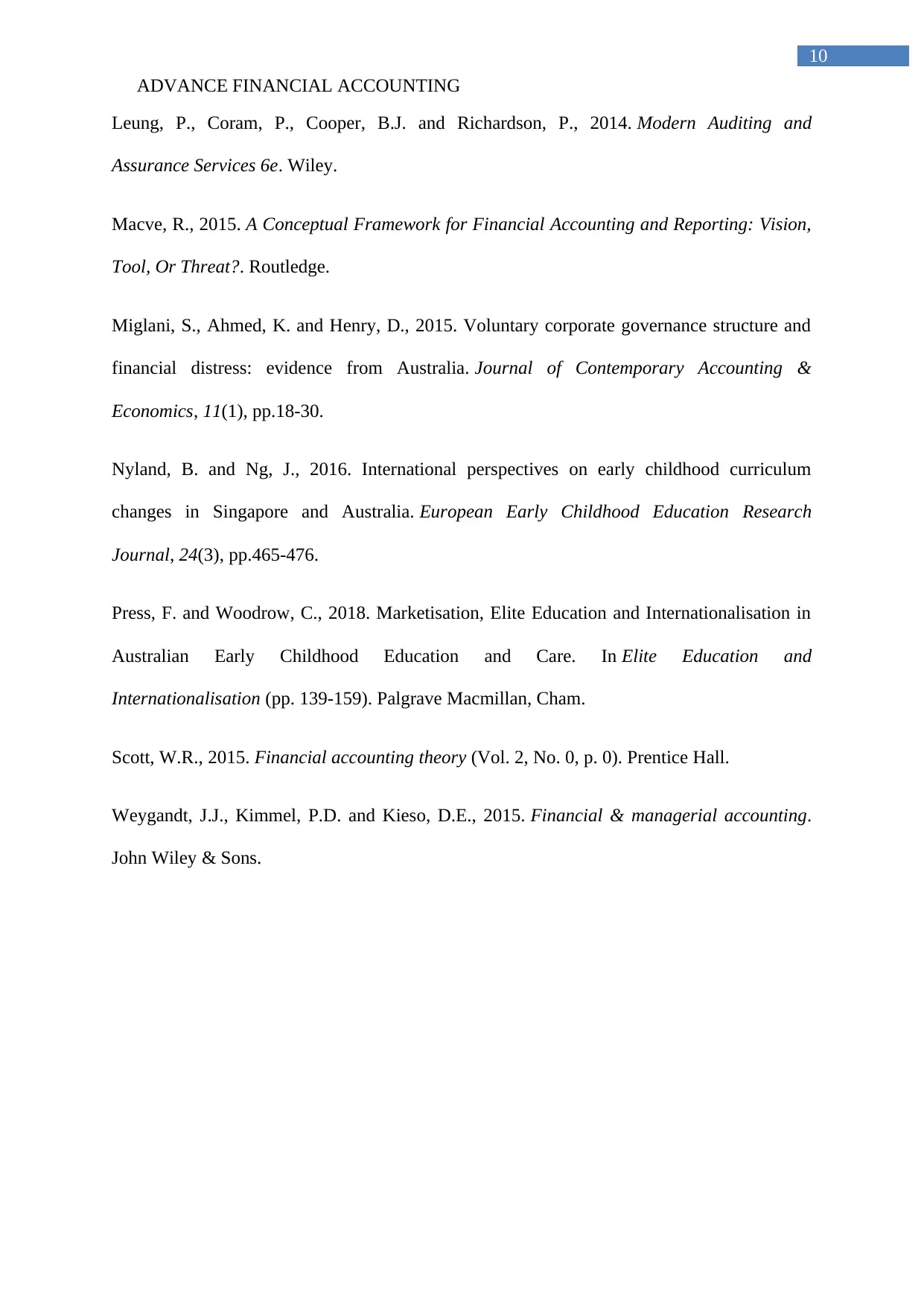
ADVANCE FINANCIAL ACCOUNTING
10
Leung, P., Coram, P., Cooper, B.J. and Richardson, P., 2014. Modern Auditing and
Assurance Services 6e. Wiley.
Macve, R., 2015. A Conceptual Framework for Financial Accounting and Reporting: Vision,
Tool, Or Threat?. Routledge.
Miglani, S., Ahmed, K. and Henry, D., 2015. Voluntary corporate governance structure and
financial distress: evidence from Australia. Journal of Contemporary Accounting &
Economics, 11(1), pp.18-30.
Nyland, B. and Ng, J., 2016. International perspectives on early childhood curriculum
changes in Singapore and Australia. European Early Childhood Education Research
Journal, 24(3), pp.465-476.
Press, F. and Woodrow, C., 2018. Marketisation, Elite Education and Internationalisation in
Australian Early Childhood Education and Care. In Elite Education and
Internationalisation (pp. 139-159). Palgrave Macmillan, Cham.
Scott, W.R., 2015. Financial accounting theory (Vol. 2, No. 0, p. 0). Prentice Hall.
Weygandt, J.J., Kimmel, P.D. and Kieso, D.E., 2015. Financial & managerial accounting.
John Wiley & Sons.
10
Leung, P., Coram, P., Cooper, B.J. and Richardson, P., 2014. Modern Auditing and
Assurance Services 6e. Wiley.
Macve, R., 2015. A Conceptual Framework for Financial Accounting and Reporting: Vision,
Tool, Or Threat?. Routledge.
Miglani, S., Ahmed, K. and Henry, D., 2015. Voluntary corporate governance structure and
financial distress: evidence from Australia. Journal of Contemporary Accounting &
Economics, 11(1), pp.18-30.
Nyland, B. and Ng, J., 2016. International perspectives on early childhood curriculum
changes in Singapore and Australia. European Early Childhood Education Research
Journal, 24(3), pp.465-476.
Press, F. and Woodrow, C., 2018. Marketisation, Elite Education and Internationalisation in
Australian Early Childhood Education and Care. In Elite Education and
Internationalisation (pp. 139-159). Palgrave Macmillan, Cham.
Scott, W.R., 2015. Financial accounting theory (Vol. 2, No. 0, p. 0). Prentice Hall.
Weygandt, J.J., Kimmel, P.D. and Kieso, D.E., 2015. Financial & managerial accounting.
John Wiley & Sons.
1 out of 11
Related Documents
Your All-in-One AI-Powered Toolkit for Academic Success.
+13062052269
info@desklib.com
Available 24*7 on WhatsApp / Email
![[object Object]](/_next/static/media/star-bottom.7253800d.svg)
Unlock your academic potential
Copyright © 2020–2025 A2Z Services. All Rights Reserved. Developed and managed by ZUCOL.





